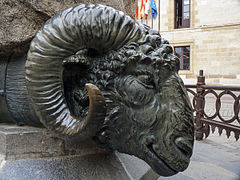Monument to Viriathus (Zamora)
 | |
 | |
| 41°30′09″N 5°44′54″W / 41.502494°N 5.748472°W | |
| Location | Plaza de Viriato, Zamora, Spain |
|---|---|
| Designer | Eduardo Barrón |
| Material | Bronze, granite |
| Height | 2 m (statue) |
| Opening date | 12 January 1904 |
| Dedicated to | Viriathus |
Viriato or the Monument to Viriathus is an instance of public art in Zamora, Spain. Dedicated to Viriathus and located in the eponymous plaza, the monument consists of a bronze sculpture of the Lusitanian chieftain-shepherd put on an unpolished stone pedestal that features a battering ram.
History and description[edit]
The statue is a work by Eduardo Barrón cast in bronze in Rome at Nelli's foundry in 1883; it was later bought by the Spanish State.[1]
The leading statue of the sculptural ensemble represents a standing and almost naked full-body figure of Viriathus, with his right arm extended in attitude of rallying his troops, while the left forearm holds a tunic and the left hand grabs a sheathed sword below the level of an abnormally long handle (creating a phallic perception from certain angles).[2][3]
The statue stands 2-metre high and its bronze base reads terror romanorum ("terror of the Romans"),[4] an epithet for Viriathus attributed to the Orosius' chronicles. The statue and the quadrangular base stand on a granite pedestal taken from Torrefrades, one of the pretenders claimed to be the Viriatho's birthplace.[5] The granite block features a battering ram emerging from its front side,[1] cast in bronze in 1903.[6]
Failing to undergo a proper ceremony of inauguration, the monument was casually unveiled by transients on 12 January 1904.[7]
The monument, with Viriathus' posture identified as performing a Roman (fascist) salute, was embraced by the Falange as an icon during the Francoist dictatorship.[8]
-
Detail of the head of the battering ram
-
Detail of the statue
References[edit]
- Citations
- ^ a b Rincón García 2017, p. 184.
- ^ Ocejo Durand 2002, p. 230.
- ^ Rincón García 2017, pp. 185–186.
- ^ Ocejo Durand 2002, p. 234.
- ^ Ocejo Durand 2002, pp. 234, 236.
- ^ Ocejo Durand 2002, p. 236.
- ^ Ocejo Durand 2002, p. 247.
- ^ Ocejo Durand 2002, p. 251.
- Bibliography
- Ocejo Durand, Nel (2002). "Estudio del grupo escultórico de Viriato de Eduardo Barrón González en Zamora" (PDF). Studia Zamorensia (6). Zamora: Universidad Nacional de Educación a Distancia: 229–254. ISSN 0214-736X – via Dialnet.
- Rincón García, Wifredo (2017). "Muerte y amor en la escultura española del siglo XIX" (PDF). In Castán Chocarro, Alberto; Lomba Serrano, Concha (eds.). Eros y Thánatos: reflexiones sobre el gusto III. pp. 183–206. ISBN 978-84-9911-434-7.


